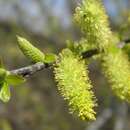pt-BR
nomes no trilho de navegação


Salix caroliniana (lat. Salix caroliniana) - söyüdkimilər fəsiləsinin söyüd cinsinə aid bitki növü.
Salix caroliniana (lat. Salix caroliniana) - söyüdkimilər fəsiləsinin söyüd cinsinə aid bitki növü.
Salix caroliniana, commonly known as the coastal plain willow, is a shrub or small tree[2] native to the southeastern United States, Mexico and parts of Central America and the Caribbean. It is an obligate wetland species and grows as an emergent species in the Everglades. In the absence of fire, S. caroliniana can convert herbaceous wetlands to forested wetlands. Although fires kill large woody stems and the species does not reproduce by rhizomes or root sprouts, it sprouts readily after fire. As a result, the total number of stems does not change, but fire converts S. caroliniana from a tree into a shrub.[2]
Salix caroliniana flowers in the early spring, either before or together with the emergence of leaves. In Alachua County, Florida in 1982, flowering was recorded during February and March.[3]
The species was first described by French naturalist André Michaux in 1803 in his Flora Boreali-Americana.[4]
The male flowers provide much spring pollen for bees. It is a larval host to the black-waved flannel moth, the blinded sphinx, the cecropia moth, the elm sphinx, the imperial moth, the Io moth, the modest sphinx, the mourning cloak, the polyphemus moth, the promethea moth, the red-spotted purple, and the viceroy.[5]
Salix caroliniana, commonly known as the coastal plain willow, is a shrub or small tree native to the southeastern United States, Mexico and parts of Central America and the Caribbean. It is an obligate wetland species and grows as an emergent species in the Everglades. In the absence of fire, S. caroliniana can convert herbaceous wetlands to forested wetlands. Although fires kill large woody stems and the species does not reproduce by rhizomes or root sprouts, it sprouts readily after fire. As a result, the total number of stems does not change, but fire converts S. caroliniana from a tree into a shrub.
Salix caroliniana flowers in the early spring, either before or together with the emergence of leaves. In Alachua County, Florida in 1982, flowering was recorded during February and March.
The species was first described by French naturalist André Michaux in 1803 in his Flora Boreali-Americana.
The male flowers provide much spring pollen for bees. It is a larval host to the black-waved flannel moth, the blinded sphinx, the cecropia moth, the elm sphinx, the imperial moth, the Io moth, the modest sphinx, the mourning cloak, the polyphemus moth, the promethea moth, the red-spotted purple, and the viceroy.
Salix caroliniana, es una especie de sauce perteneciente a la familia de las salicáceas, es un arbusto o pequeño árbol[1] nativo del sudeste de los Estados Unidos, México y parte de Centroamérica y el Caribe.
Se trata de una especie propia de los humedales y que crece como una especie emergente en el Everglades. En ausencia del fuego, S. caroliniana puede convertir los humedales herbáceos de humedales arbolados. Si bien los incendios matan a los grandes tallos leñosos y la especie que se reproduce por rizomas o brotes de la raíz, brota con facilidad después de un incendio. Como resultado, el número total de tallos no cambia, pero el fuego convierte a S. caroliniana de un árbol en un arbusto.[1]
Salix caroliniana florece de la primavera, ya sea antes o junto con la aparición de las hojas. En el condado de Alachua, Florida en 1982, la floración se registró durante febrero y marzo.[2]
Salix caroliniana fue descrita por André Michaux y publicado en Flora Boreali-Americana 2: 226, en el año 1803.[3]
Salix: nombre genérico latino para el sauce, sus ramas y madera.[4]
caroliniana: epíteto geográfico que alude a su localización en Carolina.
|coautores= (ayuda) Salix caroliniana, es una especie de sauce perteneciente a la familia de las salicáceas, es un arbusto o pequeño árbol nativo del sudeste de los Estados Unidos, México y parte de Centroamérica y el Caribe.
Salix caroliniana est une espèce de plantes de la famille des Salicaceae se rencontrant aux États-Unis, au bord de l'Ohio, de la Susquehanna et de tous leurs affluents.
Salix caroliniana ressemble beaucoup à Salix alba. Son écorce est grisâtre, finement gercée ; son bois blanc et tendre. Son feuillage est d'un vert-clair ; ses feuilles médiocrement pétiolées, alternes, étroites, alongées, lancéolées, vertes et glabres sur leurs deux faces, finement dentées en scie, dépourvues de stipules, longues d'environ six à neuf centimètres, larges d'un centimètre et demi ou plus, acuminées ; les pétioles sont pubescents.
Salix caroliniana fleurit au début du printemps, avant ou pendant l'émergence des feuilles. En Floride en 1982, la floraison a eu lieu en février et mars[1]. L'espèce a été décrite en premier par le naturaliste français André Michaux en 1803 dans Flora Boreali-Americana[2].
Salix caroliniana est une espèce de plantes de la famille des Salicaceae se rencontrant aux États-Unis, au bord de l'Ohio, de la Susquehanna et de tous leurs affluents.